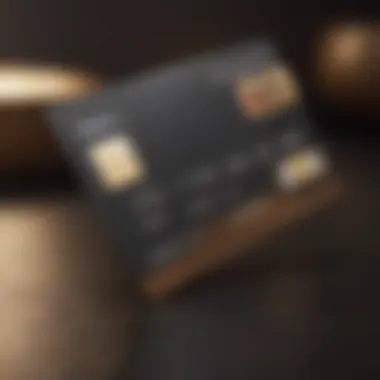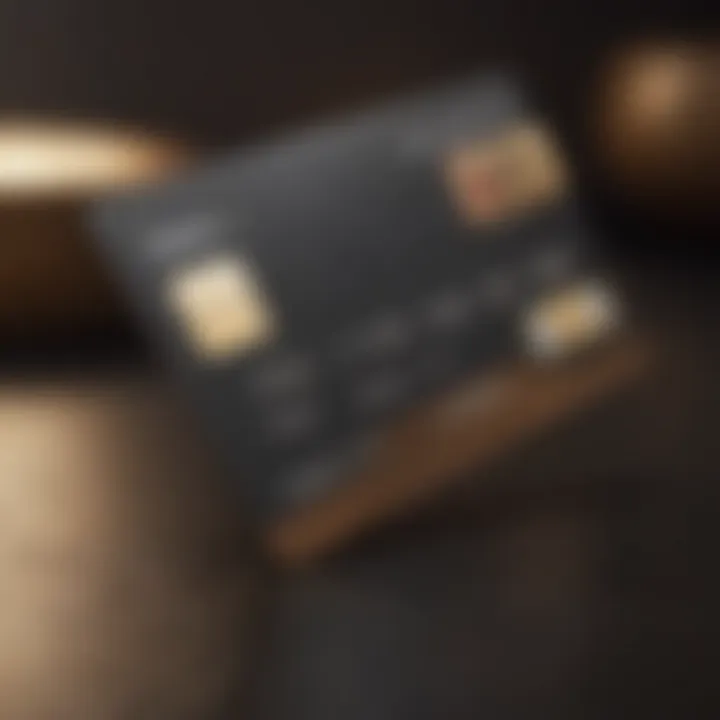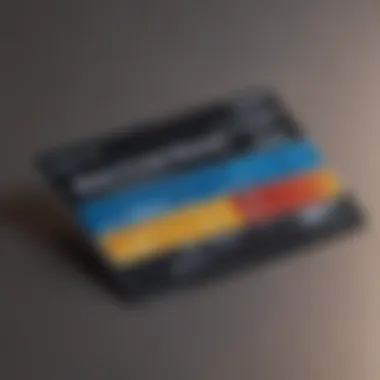In-Depth Look at the Sable Unsecured Credit Card


Intro
Navigating the world of credit cards can be a maze. For many, understanding the difference between secured and unsecured credit cards is key to building a solid financial foundation. The Sable unsecured credit card stands out in this field. But what makes it an option worth considering? In this article, we will dissect the specifics of the Sable card—its features, how it compares to secured formats, and what to expect from the application process.
You’ll gain insight into eligibility requirements, as well as the potential influence on your credit score. By the end, you should feel equipped to make a well-informed decision about using this card as a gateway to improved creditworthiness.
Investment Dictionary
Definition of Key Terms
Understanding terms related to credit cards can elevate one’s financial literacy. Here are some definitions that are particularly relevant in this discussion:
- Unsecured Credit Card: A type of credit card backed only by the cardholder's creditworthiness, without any collateral.
- Credit Score: A numerical representation of a person’s creditworthiness, usually ranging from 300 to 850. Higher scores indicate more responsible credit behavior.
- Secured Credit Card: A credit card that requires the cardholder to provide a cash deposit as collateral, often used by those with lower credit scores.
Commonly Used Financial Concepts
Knowing commonly used concepts in finance can help clarify discussions on credit cards:
- Annual Percentage Rate (APR): The yearly interest rate, which gives an idea of how much you'll pay if you carry a balance.
- Credit Utilization Ratio: This is the percentage of your total credit limits that you are currently using. Keeping this ratio low is beneficial for your credit score.
- Minimum Payment: The smallest amount you are required to pay off your credit card balance each month.
"Building good credit takes time; understanding your tools is the first step to success."
Key Features of the Sable Unsecured Credit Card
The Sable card targets a niche audience, particularly those looking to build or establish credit history without considerable barriers to entry. Here’s a brief look at its highlighted features:
- No Deposit Requirements: Unlike many secured cards, it doesn’t require an initial deposit, making it accessible to a wider audience.
- Cash Back Rewards: This card offers cash back on purchases, an appealing aspect for everyday spenders eager to make the most of their purchases.
- Global Acceptance: It can be used virtually anywhere Visa is accepted, adding to its usability for travelers or anyone making online purchases.
- Monitoring Tools: Users often appreciate features that allow them to track their spending and monitor their credit scores directly through the app.
The ease of applying for the card, along with these attractive features, puts it on the radar for many who want to improve their financial standing.
Application Process
Getting a Sable credit card isn’t as daunting as it may seem. Here are the steps involved in applying:
- Online Application: Start by visiting the Sable website or mobile app. The application process is conducted entirely online.
- Personal Information: Provide necessary information such as your name, address, Social Security number, and income.
- Instant Approval: Many applicants report receiving instant decisions on their applications, making the process efficient.
- Account Setup: If approved, you can set up your account easily, with instructions guiding you through every step.
Staying organized during this process can minimize snags and speed up approval.
Eligibility Requirements
While the Sable card is more accessible than many other unsecured cards, there are still eligibility requirements you’ll need to consider:
- Minimum Age: Generally, applicants must be at least 18 years old.
- Residency: You must be a U.S. resident.
- Income Verification: You will need to demonstrate a viable source of income for approval.
These guidelines ensure that the card is offered to individuals who are most likely to benefit from it while minimizing the risk to the issuing bank.
Impact on Credit Scores
One of the most vital considerations when choosing a credit card is how it can influence your credit score. Here’s how the Sable card can play a role:
- Payment History: As with all credit cards, responsible use and timely payments can positively impact your score over time.
- Credit Utilization: Keeping your balance low relative to your credit limit is crucial. The Sable card allows room to practice good credit habits.
- Account Age: Opening new credit accounts can initially lower your score, but maintaining the Sable card over the years can contribute positively.
Therefore, the Sable card is more than just a payment tool. It is a potential stepping stone toward a more robust credit profile.
Prelude to Unsecured Credit Cards
When it comes to navigating the complex world of credit, understanding unsecured credit cards can be incredibly pivotal. These financial instruments serve not just as means to manage expenses but are also gateways to building a robust credit profile. In this era where financial literacy is becoming increasingly crucial, having a firm grip on the function and purpose of these cards is paramount for individual investors and anyone looking to enhance their financial capabilities.
Definition and Importance
An unsecured credit card is a type of credit that does not require a cash deposit as collateral. This means that, unlike secured cards, users can borrow funds based solely on their creditworthiness. This can be especially beneficial for those who may not have the upfront cash to put down but need a pathway to establish or improve their credit score.
The importance of unsecured cards lies in their ability to offer flexibility and convenience. They often come with various perks such as rewards programs and cash back incentives, allowing consumers to earn while they spend. Additionally, responsible usage can significantly bolster one’s credit history.
A critical part of understanding unsecured credit cards is recognizing their potential effects on financial independence. They can empower individuals to make purchases when cash flow may be tight, easing immediate financial burdens. However, they also come with their own set of responsibilities and challenges that must not be overlooked, particularly regarding the temptation of overspending.
How They Differ from Secured Cards
Unsecured credit cards stand in stark contrast to secured credit cards, which require a deposit equal to the credit limit. This key difference shapes the dynamics of how each card operates and their suitability for various consumers. With secured cards, typically, users face higher initial costs, making them less accessible for some individuals. Here are a few distinctions worth noting:
- Credit Requirements: Unsecured cards may have stricter eligibility criteria compared to secured options. Individuals with low credit scores might find it easier to qualify for secured cards.
- Costs and Fees: Secured credit cards often come with lower fees due to the collateral involved, while unsecured cards might impose higher fees without that financial safety net.
- Growth Potential: Using unsecured cards responsibly can lead to enhancements in credit limits and offers. This can be less frequent with secured cards, which may limit growth opportunities.
It's clear that choosing between unsecured and secured cards should be an informed decision, weighing the pros and cons of each situation based on personal financial goals. Understanding these nuances is essential for anyone keen on enhancing their credit standing and ultimately achieving financial stability.
Overview of the Sable Unsecured Credit Card
Navigating the world of credit cards can feel like wandering through a maze with no clear exit. Yet, the Sable unsecured credit card offers a promising pathway for those looking to build or improve their credit profile. This section focuses on the core aspects of what sets this card apart from traditional options, emphasizing its potential benefits and considerations for the customer.


Key Features
When discussing the importance of the Sable unsecured credit card, one can't overlook its prominent features:
- No Security Deposit Required: Unlike secured cards, which necessitate a cash deposit that acts as collateral, the Sable card is readily available without any upfront costs. This format allows a broader audience, particularly those who may lack significant savings, the opportunity to access credit.
- Global Acceptance: Sable's card performs well internationally. One can use it like any standard Visa card at countless locations worldwide. This can be a real boon for those who travel or shop online frequently.
- Earning Rewards: The card comes with a rewards program that enables users to accumulate points for every transaction. These points can be exchanged for various perks, such as cash back or merchandise discounts, enhancing its usability beyond just credit.
- Flexible Payment Options: Sable is also known for offering flexible payment structures, allowing users to manage their budgets without stressing about strict repayment timelines.
- Built-in Credit Education: A noteworthy aspect is Sable's commitment to help cardholders understand credit scores and financial best practices through various tools and educational resources.
Such features collectively make the Sable unsecured credit card an attractive proposition for those looking to enhance their financial health while accessing credit with relative ease.
Target Audience
The target audience for the Sable card includes diverse individuals, catering primarily to:
- Newcomers to Credit: Young adults or recent graduates entering the credit market can benefit from this card, as it helps establish a credit history without the pressures of a security deposit.
- Immigrants and International Students: For those new to the country, the Sable card offers a way to build credit in a new financial landscape. Since many immigrants face challenges in establishing credit history, this card can serve as a stepping stone.
- Individuals with Limited Credit History: If someone has had difficulty qualifying for other forms of credit, the Sable card can provide an essential alternative. It's aimed at helping those who may have faced difficulties in securing a more traditional card.
- Frequent Travelers: With no foreign transaction fees, this card is an appealing choice for those who travel outside the country frequently, allowing them to spend in local currencies without worrying about hefty charges.
This card aligns well with customers seeking flexibility in their financial tools, allowing them to navigate their credit journey with confidence and ease.
As the credit landscape evolves, understanding these core features and target demographics becomes critical in making informed financial choices.
Application Process
The application process for any credit card is a crucial threshold for potential cardholders. In this case, understanding the application process for the Sable unsecured credit card can mean the difference between smooth sailing and potential headaches down the line. Knowing how this process unfolds aids in setting expectations and enhances the overall experience of applying. Moreover, being well-informed allows you to prepare your documents, understand what to anticipate, and even pinpoint any unique features of Sable's application that can be beneficial.
Step-by-Step Application Instructions
Applying for the Sable unsecured credit card is a relatively straightforward task. Here's how you can navigate through it:
- Visit the Sable Website: Navigate to the official Sable site. You’ll find a clear call to action for applying for the unsecured credit card.
- Create an Account: If you’re a new user, you will need to set up an account. This step involves providing some personal information, such as your name, email address, and phone number.
- Fill Out the Application: After logging in or creating an account, you'll need to fill out the application form. This usually requires information on your income, employment, and residency status.
- Review Your Application: Before hitting submit, go through the details you’ve entered. Make sure everything is accurate because mistakes can delay the process or even lead to denial.
- Submit Your Application: Once satisfied with your application, you can submit it. You’ll typically receive a confirmation that your application has been received.
- Await Response: Be patient. Generally, you might hear back regarding your application status within a few days. Sable often sends an email with pertinent details.
These steps ensure that you're taking the right path. The clarity with the steps also functions as a safety net, reducing pressure during the process.
Expected Processing Time
Processing times can vary quite a bit based on numerous factors. Usually, with the Sable unsecured credit card, applicants can expect the following:
- Instant Decisions: In many cases, you might receive an instant decision upon submission of your application. This can be quite a relief for those eager to get started.
- Additional Review: For some applications, especially those needing further verification, it may take a few days—generally, about 3 to 5 business days—to receive a final decision.
It’s important to keep an eye on your email during this waiting period. Sable often communicates important updates via email, so ensure your inbox is checked regularly.
"Timely application and prompt follow-up are essential to enhance your chances of a smooth process."
In all, the application process for the Sable unsecured credit card promises a streamlined experience, assuming you’re prepared and follow the requisite steps. Knowing what to expect can lessen the worry and enhance your chances of a successful application.
Eligibility Criteria
Understanding the eligibility criteria for the Sable unsecured credit card is key for any potential applicant. It provides insight into who can apply and under what conditions, ensuring that users are not left in the dark regarding their options. These criteria are not just empty boxes to tick; they can significantly influence both approval chances and the long-term benefits one can expect from the card.
Income Requirement
First and foremost, most credit cards, including the Sable unsecured card, have an income requirement. This does not mean one has to be raking in the big bucks; rather, it’s about demonstrating a steady revenue stream that suggests financial stability.
While Sable does not disclose a specific income level needed, having reliable income helps paint a picture of your ability to pay off expenses. For example, if someone is making a modest income but managing expenses well within their means, they could still qualify. This can be particularly attractive for young professionals or individuals just beginning in their careers.
Benefits of meeting the income bar include:
- Access to credit lines that better align with one's financial capability.
- Potential lower interest rates if the applicant shows strong financial management.
- Enhanced confidence from lenders knowing the applicant has a financial cushion.
Credit Score Considerations
Next, we delve into credit score considerations. While the Sable unsecured credit card often targets those with limited or poor credit history, it’s still wise to be aware of how credit scores impact the application process.
When applying, it is helpful to have some understanding of one’s credit score, which reflects credit management over time. However, Sable has broad eligibility criteria. Even those with scores on the lower end of the scale may be able to get approved. But remember, maintaining a healthy score can lead to better card conditions as users build their credit over time. Here are a few aspects regarding credit scores:
- Soft Pull Assessment: Sable typically performs a soft pull, meaning that the applicant's credit won't be impacted when checking eligibility.
- Opportunity for Improvement: Applicants can use this card to improve their credit standing by making timely payments, which will be reported to credit bureaus.
Age and Residency Conditions
Lastly, age and residency conditions are crucial factors in qualifying for the Sable unsecured credit card. To apply, one generally needs to be at least 18 years old. It is an essential requirement, as lenders often view younger applicants as riskier due to limited credit history despite the potential for responsible usage.
Moreover, applicants must be U.S. residents. This requirement ensures that the cardholders can access customer service effectively whenever required and can meet tax obligations. Being a resident also makes tracking the credit activity easier.
In summary, these eligibility criteria — income, credit score, and age/residency — serve as key gateways to accessing the Sable unsecured credit card. They set the stage for your financial journey. Given that many individuals aim to build their credit from the ground up, understanding these points helps in crafting an informed approach.
Benefits of the Sable Unsecured Credit Card
Navigating the world of credit cards can be a tricky endeavor, especially when it comes to selecting the right one for your needs. The Sable Unsecured Credit Card offers a unique blend of features and benefits that can aid those who are looking to build their credit score while enjoying certain perks. In this section, we delve into some of the pivotal advantages that come with this card, particularly focusing on its capacity for credit building, the rewards it provides, and the absence of foreign transaction fees.
Credit Building Potential


One of the defining characteristics of the Sable unsecured credit card is its potential for helping users establish or improve their credit score. Whether you're starting from scratch or working to recover from past financial missteps, having a tool that reports to the major credit bureaus is crucial. With the Sable card, timely payments are reported, which means every responsible action you take positively reflects on your credit history.
Here are some considerations regarding the credit-building advantages:
- Consistency is Key: Regular use of the card and, more importantly, on-time payments can lead to a substantial enhancement in your credit score.
- Credit Utilization Ratio: By keeping your balance low relative to your limit, you're also cultivating a healthier credit utilization ratio, which plays a major role in credit score calculations.
- Opportunity for Gradual Limit Increases: If you show responsible usage, Sable may reward you with higher limits over time, further aiding your credit health.
This makes the Sable card not just a financial tool, but a strategic ally in your journey toward a healthier credit profile.
Rewards and Cash Back Programs
Another major allure is the rewards and cash back opportunities provided by the Sable unsecured credit card. Not all credit cards offer this feature, particularly those tailored for individuals with less established credit. Here’s why the Sable card stands out:
- Flexible Rewards: Users can earn cash back on various purchases, which may make it more appealing for regular expenses like groceries, gas, or dining out.
- Sign-Up Bonuses: Occasionally, new cardholders may encounter promotional offers that provide additional bonuses after meeting a specified spending threshold.
- Competitive Cashback Rates: The cashback rates can sometimes rival those of more traditional credit cards, providing a tangible benefit over just credit-building alone.
This feature can transform spending into saving, allowing cardholders to benefit from their regular transactions while they’re building credit.
No Foreign Transaction Fees
Finally, the absence of foreign transaction fees is a game changer for those who travel or make purchases in different currencies. Traditional credit cards often add a surcharge that can range from 1% to 3%, which can add up quickly, especially for frequent travelers. Here's how this benefit plays out:
- Cost Effective Travel: Cardholders can use their Sable card while abroad without worrying about extra charges creeping into their bills.
- Ease of Use: With Sable's global acceptance, it removes the headache of constantly exchanging local currency or carrying large amounts of cash.
- Safe Transactions: Using a credit card instead of cash while traveling reduces the risk of loss or theft, providing peace of mind.
This makes the Sable Unsecured Credit Card not only a practical option for everyday spending but also a smart choice for international travel.
In summary, the Sable Unsecured Credit Card offers a robust range of benefits that go hand-in-hand with responsible usage. Whether it’s through enhancing your credit score, offering rewards and cash back, or allowing seamless international use, it stands out in a crowded marketplace as a viable option for both credit newbies and seasoned users alike.
Drawbacks to Consider
When discussing the Sable unsecured credit card, it's crucial to address the drawbacks involved. While this card offers several attractive features aimed at helping users build credit without collateral, the potential negative aspects deserve careful scrutiny. Understanding these drawbacks can help individuals navigate their financial choices and make more informed decisions.
Potential for High Fees
One of the most significant considerations that users must contemplate is the potential for high fees associated with the Sable unsecured credit card. Depending on the individual’s usage, costs could pile up. Monthly maintenance fees, late payment fees, and even cash advance fees can catch cardholders off guard. If these costs are not managed properly, they can undermine the financial benefits the card is meant to provide.
- Monthly Maintenance Fees: While some users expect a $0 annual fee, variances may occur based on specific conditions. It's essential to clarify these details before applying, as certain user behaviors could trigger fees.
- Transaction Fees: Particularly when using the card for international purchases, fees can pose a dilemma. Users might find themselves paying more than anticipated, especially if they're outside their home country.
- Late Payment Fees: Life happens, and sometimes bills slip through the cracks. A missed payment can lead to high fees, potentially offsetting any gains from responsible credit use.
Ultimately, understanding these fees and determining if they align with one's financial habits is vital in deciding whether this card is the right fit.
Impact on Credit Score
Another noteworthy component when evaluating the Sable unsecured credit card is its potential impact on credit scores. For individuals eager to establish or improve their credit profile, this aspect can either work as a springboard or a stumbling block.
In general, unsecured cards, like Sable’s offering, have the potential to positively impact credit scores, provided they’re used responsibly. However, there are caveats:
- Hard Inquiries: Applying for the card results in a hard inquiry on your credit report. Multiple applications in a short span can raise red flags, affecting your score temporarily.
- Credit Utilization Ratio: Maintaining a high balance relative to the credit limit can put a dent in your score. Always aim to maintain a low utilization ratio, ideally under 30%, to keep your credit healthy.
- Default Consequences: Failing to meet payment obligations can dramatically harm your credit score. Consistent late or missed payments signal risk to lenders and can create hurdles down the line.
Comparative Analysis
When it comes to understanding the full value of the Sable Unsecured Credit Card, a comparative analysis serves as an essential tool. This section seeks to juxtapose it with similar offerings, helping potential cardholders make a well-informed choice. The relevance of this topic cannot be overstated; people often find themselves navigating a sea of options, and without a clear roadmap, it's easy to end up making a decision based on surface-level features rather than an in-depth understanding.
This analysis not only highlights where the Sable card shines but also sheds light on areas where it might not meet certain expectations, giving readers a balanced view. This understanding is particularly useful for discerning financial enthusiasts and individual investors who prioritize optimizing their credit strategies.
Sable vs. Other Unsecured Cards
In the landscape of unsecured credit cards, Sable presents a unique offering that sets it apart from its competitors. Many unsecured credit cards come with hidden fees or stringent criteria that can discourage prospective users. Sable, however, distinguishes itself through its user-friendly approach, catering to individuals who may be new to credit.
- No Minimum Deposit: Unlike some other unsecured cards that may require a hefty initial deposit to secure a line of credit, Sable allows users to start using their card immediately upon approval, making it more accessible.
- Adaptive Credit Limits: Sable employs a unique algorithm that can adjust credit limits based on user behavior and credit utilization, which can prove beneficial for those actively managing their finances.
- Rewards Program: While many unsecured cards offer basic cash back, Sable’s program is robust, encouraging responsible spending with attractive perks that resonate with a global audience, notably travelers who prefer no foreign transaction fees.
However, it’s important to note that while Sable shines in some areas, other cards might excel in offering lower interest rates or higher cash-back percentages. Therefore, it’s crucial to evaluate personal spending habits and objectives when making a choice.
Sable vs. Secured Credit Cards
Another worthy consideration is the comparison of Sable with secured credit cards. Secured cards often require a security deposit, which can limit access for those who might be financially tight. In contrast, Sable offers a more flexible approach.
- No Need for a Deposit: With Sable, users can utilize unsecured credit lines without putting down a deposit. This can make a significant difference for individuals who may not have available funds to lock up.
- Flexibility in Payments: Secured cards often have stringent policies regarding payment history and utilization; Sable, on the other hand, focuses on adaptability which can enhance the user experience.
- Build Credit without Compromise: Using a secured card responsibly can build credit, but many users feel locked into their financial commitments. Sable simultaneously allows for credit building while providing a structure that encourages growth without the anxiety of upfront deposits.
That said, secured cards do have their merits. For example, they are often easier to obtain for individuals with very limited or poor credit histories. Some may prefer the structured environment they provide, especially while starting their credit journey.
In sum, diving into the comparative landscape of Sable allows consumers to weigh the scales of various offerings meaningfully. It ultimately boils down to personal preference and financial needs, underscoring the importance of evaluating not just features but also how they align with individual financial strategies.
How to Use the Card Responsibly
Using the Sable unsecured credit card can be a valuable way to build credit, but it requires a responsible approach to maximize the benefits and avoid unnecessary pitfalls. The key to successful credit card usage lies not merely in spending; it’s about forging healthy financial habits. In this section, we will explore practical strategies that can help ensure the Sable card works for you instead of against you.
Developing a Budget
Creating a budget is a key part of managing any financial tool with finesse. Here’s why budgeting is crucial when using an unsecured credit card like Sable:


- Understanding Income and Expenses: Budgeting allows you to get a clear picture of what you earn versus what you spend. It helps prevent overspending, something many cardholders fall into.
- Setting Spending Limits: By categorizing your expenses – say groceries, entertainment, and bills – you can easily allocate portions of your budget to each. This means you can enjoy using your Sable card without racking up debt.
- Building a Savings Cushion: A budget isn’t just about spending. It should also aim to grow an emergency fund. This way, when unexpected expenses arise, you're less likely to rely solely on your credit card.
Remember, it’s not simply about adding numbers on a page; it’s about building a plan that reflects your life and goals. As the saying goes, "Failing to plan is planning to fail."
Timely Payments
Making timely payments should be at the forefront of your credit card strategy. Not only does this habit safeguard your credit score, but it also helps avoid costly late fees. Here’s what you need to consider:
- Set Reminders: Use calendar alerts or apps to remind you when payments are due. A little nudge can prevent missed payments and keep your account in good standing.
- Pay More Than the Minimum: While this is tempting, only paying the minimum often results in accumulating interest. By paying more, you can chip away at your balance more effectively.
- Establish Autopay: Many banks offer the option to set up automatic payments. This ensures you never miss a due date, protecting your financial health in the long run.
Overall, timely payments not only avoid pitfalls but can also help improve your credit score, something every cardholder should actively seek.
Avoiding Debt Accumulation
Debt, once it starts to accumulate, can often feel like a snowball rolling down a hill—gaining speed and size the longer it goes unchecked. So, let’s look at some ways to avoid falling into this trap:
- Regularly Review Your Statements: Keeping an eye on your account activity helps ensure you're aware of where your money is going. Spotting suspicious charges can save you from bigger issues down the road.
- Limit Card Usage for Non-Essentials: Using your card for impulse purchases or things you don’t need can add up quickly. Stick to your budget and be discerning with your spending habits.
- Seek Help if Necessary: If you find yourself in a tough spot, don't hesitate to reach out for help. Financial counseling can provide valuable insights on managing debt.
"Knowledge is power, and adopting these practices will empower you to maintain your credit health and financial stability."
Being informed and proactive can make all the difference in fostering a sustainable financial future.
Customer Experiences
Understanding customer experiences with the Sable Unsecured Credit Card provides invaluable insights into its overall value and effectiveness. The way users interact with a financial product can reveal a lot about its operations, strengths, and potential shortcomings. Real-life feedback shapes the broader narrative around what it truly means to own this card. Users can share their stories, whether positive or negative, which lends authenticity to the learning process for potential cardholders. It’s one thing to read features and specs, but quite another to hear about practical experiences.
User Reviews and Testimonials
When it comes to user reviews, these opinions often weigh heavily in the decision-making process for new applicants. Many individuals have taken to various platforms like Reddit and Facebook to express their thoughts on the Sable Unsecured Credit Card.
Some users praise the card for its accessibility and ease of use. They often highlight how straightforward the application process is, which is a critical factor, especially for those new to credit options. Testimonials frequently mention that the ability to build credit with responsible usage is a significant advantage. One user noted, "I didn't think I could improve my credit score. After a few months with Sable, I saw a noticeable jump!"
Conversely, there are users who have shared concerns about customer service response times. Frustration can arise when queries or issues don't get timely resolutions, which could leave a sour taste for potential applicants. Users say things like, "If you have a problem, don't expect a quick reply; it can be a waiting game." This spectrum of user experiences paints a comprehensive picture and guides others in their decisions.
Common Themes in Feedback
While individual opinions can vary, certain trends emerge when analyzing user feedback. Here are some prevalent themes:
- Credit Building: Most users agree that the Sable Unsecured Credit Card is effective for building credit. They frequently mention improvements in credit scores after consistent, timely payments.
- User-Friendliness: Many reviews reflect a sense of satisfaction regarding how easy it is to manage the account via the Sable app, which is often recommended for its clean interface.
- Communication Challenges: A recurring theme in various accounts involves difficulties in reaching customer support. Customers mention how it can be frustrating when issues arise, indicating a need for better communication channels.
- Fee Awareness: Some users express worries about the potential for hidden fees. They urge prospective cardholders to read the fine print carefully, a cautionary reminder that highlights the importance of understanding credit agreements.
"You gotta fully grasp the terms before diving into anything financial. A stitch in time saves nine!"
The insight from customer experiences throughout these reviews and testimonials is essential for anyone considering the Sable Unsecured Credit Card. This guidance, drawn from real-life accounts, helps potential users to weigh the pros and cons thoughtfully and navigate their financial choices with effective awareness.
Alternatives to Sable Unsecured Credit Card
When considering the Sable unsecured credit card, it's vital to explore what else is out there. Knowing various options helps individuals make decisions that align with their financial goals. In this section, we’ll dissect some noteworthy alternatives, examining what they bring to the table, how they stack up against Sable, and the potential benefits they might offer for different financial situations.
Other Unsecured Options
There are several other unsecured credit cards that might catch your eye. Each of these options has its own set of features, fees, and advantages:
- Discover it® Cash Back
This card comes with a unique rewards structure. During the first year, you can earn 5% cash back on rotating categories, which can be quite generous if you time your purchases right. After that, you still earn a solid 1% on other purchases. - Chase Freedom Unlimited®
Offering unlimited 1.5% cash back on every purchase, this card can be a straightforward choice for those who prefer simplicity over complex reward structures. Additionally, new users may qualify for a welcome bonus after meeting a certain spend requirement. - Capital One QuicksilverOne Cash Rewards Credit Card
Aimed at those with average credit scores, this card offers 1.5% cash back on all purchases. While it does come with a $39 annual fee, this is often offset by the rewards you can earn.
Each of these cards presents a unique opportunity to build credit or earn rewards, without needing a cash deposit like secured cards require. Carefully weighing the ins and outs can ensure that you choose a card aligning with your spending habits and financial aspirations.
Benefits of Secured Cards
Secured credit cards can seem a bit old-fashioned, but they also serve a vital role in building and repairing credit. Here are some benefits to consider:
- Easier Approval Process
Secured cards tend to have less stringent approval requirements than unsecured cards, making them accessible for those with poor or no credit history. - Low Risk for Issuers
Because they require a cash deposit that acts as collateral, issuers are more willing to offer credit. This reduces risk, making secured cards a safer bet for banks. - Credit Score Improvement
Regular, responsible use of a secured credit card can help individuals bolster their credit scores, given they make timely payments and keep balances low. - Potential for Transitioning
Many issuers will review accounts after a period, allowing good customers to transition to unsecured credit cards, which can come with better benefits.
Embracing the world of secured cards might not seem glamorous, but for many, they serve as a stepping stone to better credit opportunities. This controlled approach can set the foundation for a healthy financial future.
"When it comes to credit, understanding your options is half the battle. Exploring alternatives ensures you're equipped to make informed decisions tailored to your unique financial situation."
By understanding and contemplating these alternatives, readers are better positioned to navigate their credit journeys. Whether opting for another unsecured option or considering the structured support of a secured card, choices abound, each with its distinct advantages.
End
Understanding the Sable unsecured credit card is essential for anyone considering their financial portfolio. Not only does it offer alternatives to traditional secured credit cards, but it also stands out in a crowded market. With its unique features and benefits, it appeals strongly to both new credit users and those trying to rebuild their credit histories.
Final Thoughts on Sable Unsecured Credit Card
The Sable unsecured credit card presents a favorable opportunity for individuals to develop their credit scores without the need for collateral. What makes this card particularly appealing is its inclusive nature, allowing various demographics, including newcomers to the U.S. or those with limited credit histories, a chance to access credit. Moreover, the absence of foreign transaction fees broadens its allure for international travelers who want to avoid extra costs while abroad.
However, to truly maximize the benefits of the Sable card, users must adopt disciplined financial habits. Lacking such responsibility may lead to pitfalls such as accumulating debt gracefully and hence harming their credit score. Users need to think of this card as a tool for growth, aiming for long-term objectives rather than immediate gratification.
Making Informed Financial Choices
Being financially literate in this day and age is not just a catchphrase; it's a necessity. When considering options like the Sable unsecured credit card, one needs to weigh the pros and cons critically. This card can help build credit, but if mismanaged, it may also adversely impact one’s financial health.
- Take Time to Research: Before making a commitment, comparing the Sable card with other unsecured and secured cards is wise.
- Understand Financial Responsibilities: Knowing what fees might apply and the consequences of missing payments helps prevent unpleasant surprises in the future.
- Stay Informed About Credit Scores: Regular monitoring of credit reports can help users grasp how their actions affect their scores.
Above all, mindful decision-making is the cornerstone of maintaining a healthy financial life. With the right practices in place, the Sable unsecured credit card can be a stepping stone toward greater financial stability.



